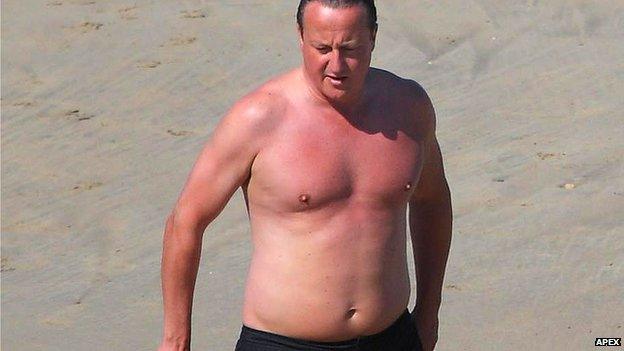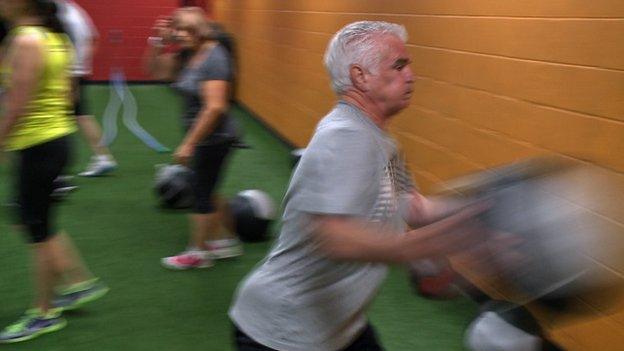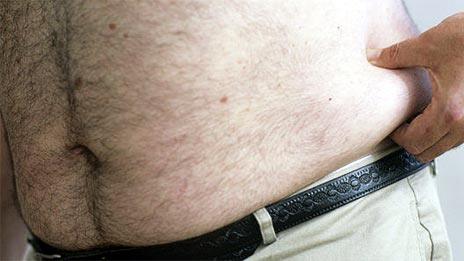Why weight gain in middle age is not inevitable
- Published
- comments

It makes men and women despair. A bulging waistline and a protruding belly are often the first signs that middle age has taken over.
Somehow, that flabby spare tyre around the middle is almost guaranteed to form in our 40s, stretching our clothes to previously unknown limits and sending us scurrying for the diet plans.
Just ask David Cameron, 46, who was photographed topless on a Cornwall beach this week looking "portly", according to the Daily Mirror.
In his defence, beachwear is rarely the most flattering attire and Mr Cameron is a very busy man.
The prime minister has a stressful job; he must have very little time for doing the recommended two-and-a-half hours of physical activity a week, and all those state banquets and cabinet lunches are bound to lead to a high-calorie intake.
However, Mr Cameron is regularly seen cycling to work and jogging in his spare time so he does manage to exercise.
This is important because an unhealthy lifestyle in middle-age can increase the amount of abdominal fat in the body - and that type of fat is particularly dangerous.
The bad news is that carrying excess weight, particularly around the waist, will increase the risk of developing heart disease, stroke, some cancers and type-2 diabetes.
Energetic hobbies
Michael Symonds, professor of developmental physiology at the University of Nottingham, says the answer is to adopt a healthy lifestyle - or find a hobby that expends lots of energy.
"I've got two allotments, six children and I bike 20 miles a day," he says. "I'm the same weight as I was when I was in my 20s."
He also recommends avoiding processed foods high in sugar and fat, growing your own vegetables and reducing work stress.
He adds: "Research shows that disrupted sleep patterns can have an impact too. The propensity to obesity is more prevalent in shift workers because of this fact."
The PM should definitely take note.
Katya Mileva, senior research fellow at London South Bank University's Academy of Sport, says dancing is an amazing way of keeping healthy, particularly into our 50s and 60s.
"Energetic salsa or Latin dancing is a really dynamic, aerobic activity which can offset almost everything else."
As well as keeping the body healthy, she recommends gentle exercise for the mind too in the form of tai chi or yoga.
Waist measurement
How to tackle an expanding waistline is mostly common sense, but the issue is knowing when we need to act - and summer photos are a useful tool in exposing our embarrassing bulges.
The next step is to measure the circumference of your waist which is a good way of checking out just how healthy you are.
The National Obesity Forum, external says that a waist circumference of more than 35in (88.9cm) for women and 40in (102cm) for men represents a "substantially increased risk" of developing heart disease and type-2 diabetes.
Even a waist circumference of 32in (81.3cm) for women, and 37in (94cm) for men indicates an increased risk.
Experts say this is because an accumulation of fat around the tummy contributes to the narrowing and hardening of the arteries, but fat around the hips does not.
Alternatively, researchers say ideally everyone should keep their waist measurement to less than half their height, external - which means that a 6ft-tall man should have a waist less than 36in, while a 5ft 4in woman should keep hers under 32in.
But David Cameron, like many of us, will no doubt be cheered to find out that it is easier to gain weight as we get older because our body composition changes.
Prof Symonds says it is part of a natural process.
"Between the age of 30 and 40 people tend to do less exercise and changes in metabolism predispose you to laying down more fat."
Muscle loss
Brown fat, or good fat - which is present in all of us when we are babies - steadily declines when we are children and by the time we are middle-aged it is replaced by white fat, the bad stuff, which clings to waistlines and hips.
At the same time as gaining fat tissue, we lose muscle as we get older. This causes our energy needs to drop because fat tissue requires less energy (or calories) to maintain its functions compared to muscle.
Dr Emma Williams, nutrition scientist from the British Nutrition Foundation, says this is when the problems begin.
"Many people also become less active as they age. If you're burning fewer calories and you haven't changed your diet, you're going to gain weight.
"Hormonal changes also influence body fat distribution so we become more likely to lay fat around the middle."
Middle-aged parents, who have been very active looking after young children, may be tempted to stand back when they become teenagers and enjoy the barbecues and the beer a little too much.
But the truth is that we just don't need to eat as much post-middle age and we still need to keep active.
- Published18 February 2013

- Published29 July 2012
- Published3 May 2011
